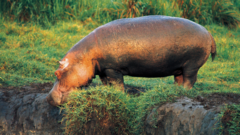In a troubling development for wildlife conservation, at least 50 hippos and other large animals have succumbed to anthrax poisoning in Virunga National Park, located in the Democratic Republic of Congo (DRC). The park's director, Emmanuel De Merode, reported that the first instances were observed last week, with images capturing the remains of the animals floating along the Ishasha River. While the exact source of the infection remains uncertain, definitive tests confirm the presence of anthrax.
Efforts are underway to dispose of the deceased animals to minimize the risk of further contamination, but logistical issues have complicated these efforts. "The process is challenging due to our limited access and resources," De Merode informed Reuters. "We aim to control the spread by burying the carcasses with caustic soda." The Ishasha River, which flows north to Lake Edward—one of Africa's prominent lakes—has seen reports of additional dead wildlife.
Anthrax, caused by the bacterium Bacillus anthracis, is capable of being lethal; however, it typically does not spread rapidly. It can lie dormant as spores in the soil for years before infecting animals through inhalation or open wounds. The Congolese Institute for the Conservation of Nature has advised local communities to steer clear of wildlife and to boil water sourced from local streams before consumption.
Spanning approximately 7,800 square kilometers (3,000 square miles), Virunga National Park is renowned for its biodiversity but has also faced significant security challenges due to clashes between various rebel factions and government forces. The park, a notable tourist attraction, has been the site of numerous armed confrontations, endangering the lives of many park rangers who strive to protect endangered species.
In recent years, various initiatives have been implemented to bolster the hippo population, which drastically declined due to poaching and conflict, reducing numbers from over 20,000 to just a few hundred. As the region confronts both conservation challenges and violence, the dramatic impact of anthrax on hippos further complicates efforts to preserve these vulnerable animals.
Efforts are underway to dispose of the deceased animals to minimize the risk of further contamination, but logistical issues have complicated these efforts. "The process is challenging due to our limited access and resources," De Merode informed Reuters. "We aim to control the spread by burying the carcasses with caustic soda." The Ishasha River, which flows north to Lake Edward—one of Africa's prominent lakes—has seen reports of additional dead wildlife.
Anthrax, caused by the bacterium Bacillus anthracis, is capable of being lethal; however, it typically does not spread rapidly. It can lie dormant as spores in the soil for years before infecting animals through inhalation or open wounds. The Congolese Institute for the Conservation of Nature has advised local communities to steer clear of wildlife and to boil water sourced from local streams before consumption.
Spanning approximately 7,800 square kilometers (3,000 square miles), Virunga National Park is renowned for its biodiversity but has also faced significant security challenges due to clashes between various rebel factions and government forces. The park, a notable tourist attraction, has been the site of numerous armed confrontations, endangering the lives of many park rangers who strive to protect endangered species.
In recent years, various initiatives have been implemented to bolster the hippo population, which drastically declined due to poaching and conflict, reducing numbers from over 20,000 to just a few hundred. As the region confronts both conservation challenges and violence, the dramatic impact of anthrax on hippos further complicates efforts to preserve these vulnerable animals.

















